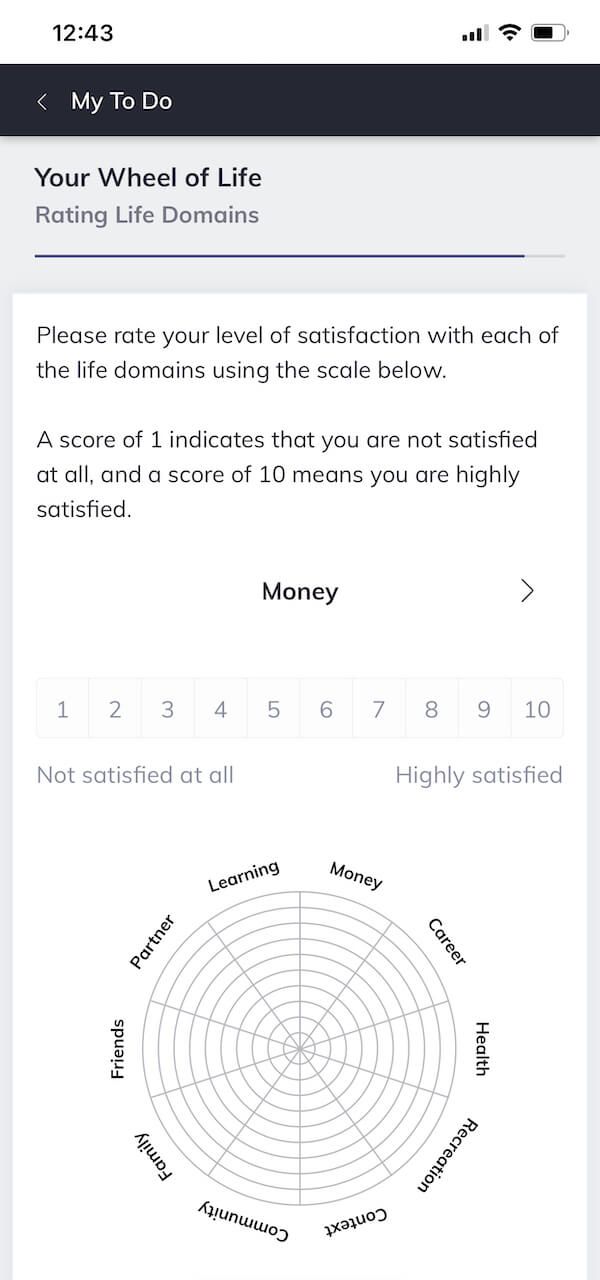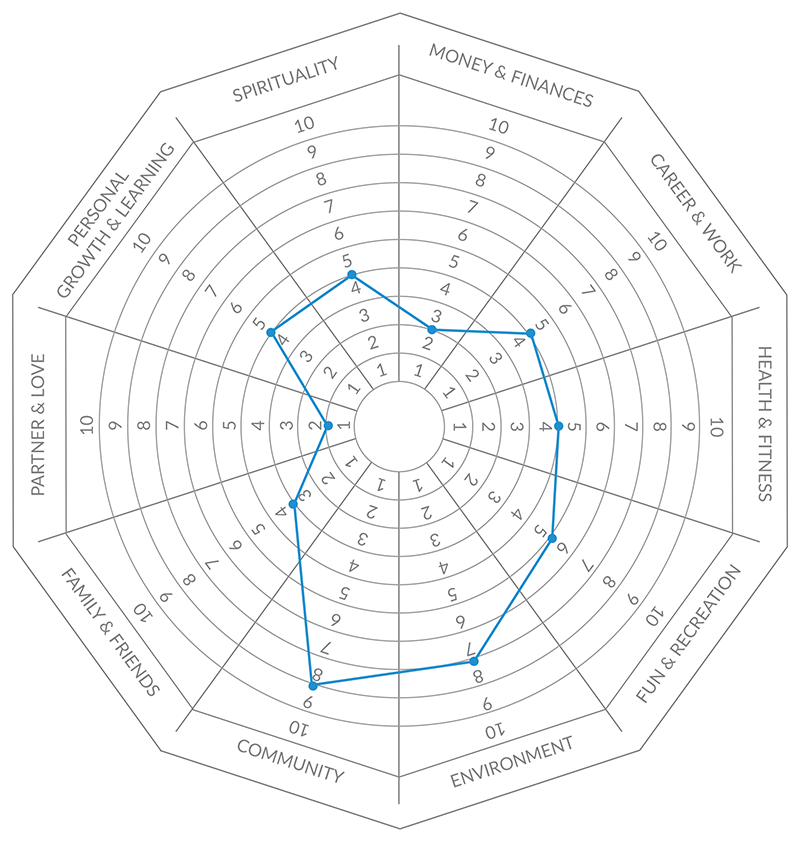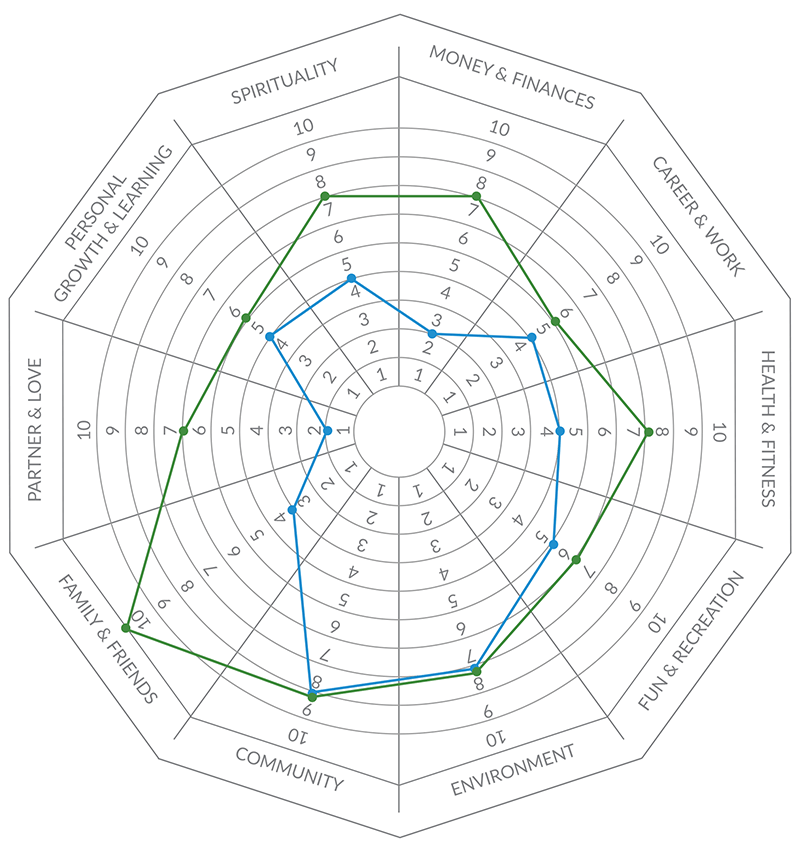How to Apply the Wheel of Life in Coaching
 Have you ever felt that your life is off kilter?
Have you ever felt that your life is off kilter?
While some areas receive all of your attention, others get none. Perhaps your career is on track, but you no longer have time for your family and friends, or your work is unfulfilling, and you are not growing or learning.
You are not alone. Harmony in life – relationships, career, health, spirituality, finances, and beyond – is hard to achieve and seemingly impossible to maintain.
Achieving a balanced existence is essential.
After all, your mental wellbeing is underpinned by finding high levels of meaning within your daily tasks and activities. If the many aspects of your being find balance, then life satisfaction, the fulfillment of basic psychological needs, and contentment usually follow (Eakman, 2016).
So, how do you find balance in your life?
What often holds people back is a lack of conscious awareness regarding their lifestyle.
Life coaching can help by focusing on where you are now and where you want to be.
In this article, we look at the Wheel of Life, a tool that continues to prove popular in life coaching and self-help. It offers enormous insight into aspects of your being that are flourishing or struggling and helps guide you to the changes needed to remove barriers and push forward.
Before you read on, we thought you might like to download our three Positive Psychology Exercises for free. These science-based exercises explore fundamental aspects of positive psychology, including strengths, values, and self-compassion, and will give you the tools to enhance the wellbeing of your clients, students, or employees.
This Article Contains:
What Is the Wheel of Life?
Being overwhelmed – unable to connect and balance the essential dimensions of your life – can leave you feeling out of control and unsatisfied.
But how does it happen?
According to Eakman (2106), your life moves out of balance “when the fulfillment of basic psychological needs has been thwarted within ongoing patterns of day-to-day occupations” and it causes harm to your wellbeing.
Put more simply, your life is out of balance when your basic psychological needs, including autonomy, relatedness, and competence, are no longer being met (Ryan & Deci, 2018). Perhaps you are focusing too much on your family while your relationship with your partner slips away, or you are prioritizing your finances over your spiritual growth.
And yet, this can cause real harm to both your body and mind, including high levels of stress.
To lead a more fulfilling existence and achieve your life goals, you must regain equilibrium.
An appropriate work–life balance will enhance your overall wellbeing by identifying and aligning the many facets – family, friends, health, work environment, and spirit – of your life (Byrne, 2005).
Performing the Wheel of Life exercise will support this process by balancing factors that influence overall wellbeing while identifying areas of life where support, guidance, and additional focus are needed.
Introducing the Wheel of Life
The original idea behind the Wheel of Life came from industry pioneer Paul J. Meyer in the 1960s to help people realize their goals.
While the wheel today has many different forms and names, including the Life Balance Wheel, Coaching Wheel, and the Wheel of Success, they share a common purpose: transformation.
The Wheel of Life exercise is widely used in coaching and beyond and offers a practical and flexible tool for clients to assess their needs and set goals aligned with their core values.
Its beauty is its simplicity.
The wheel typically consists of between eight and ten categories essential for a fulfilling life.
Segment names vary, but the themes are usually similar, for example:
- Money & Finances
- Career & Work
- Health & Fitness
- Fun & Recreation
- Environment (home/work)
- Community
- Family & Friends
- Partner & Love
- Personal Growth & Learning
- Spirituality
A score is placed in each segment to reflect the current level of satisfaction, usually represented using either of the following two designs:
“Pie” style
Using a pre-drawn diagram, such as the one below, a number is circled (or filled in) next to the appropriate dimension.
If a template is not available, create a hand-drawn version. The user writes the score against each empty, named segment, and a line marks the outside of the wheel.
“Spider web” style
It is typically generated by online coaching tools.
The markings are drawn automatically in response to input from the client.
What is it for?
The Wheel of Life provides a snapshot of your wellbeing and the level of satisfaction in your current circumstances.
At a high level, the exercise provides insight into whether or not your life is in balance. From a more detailed perspective, it captures whether individual areas of your life are either meeting your needs and making you happy or leaving you dissatisfied and discontented.
By scoring each category, you identify areas that need support and improvement to reach individual and overall life goals.
The process of writing down, reviewing, and agreeing upon ratings not only provides input to the goal-setting process, but also offers insights into areas of your life that are causing you difficulty.
The Wheel of Life can be used by anyone, with little or no training, but is commonly completed during coaching sessions to identify and agree on priorities for future exploration.
How to Use It in Life Coaching

Alternatively, coaches might consider inviting their clients to complete the Wheel of Life digitally before a coaching session. Then, they can explore their ratings for each particular domain during their in-person discussion with the coach.
For a great tool for the job, check out the coaching app Quenza, which includes the Wheel of Life in its library of coaching and psychoeducational activities that coaches can share directly to their clients’ Android or iOS devices.
When completing the Wheel of Life, the client scores each category on the wheel between one and ten (or sometimes one and five) to represent their level of satisfaction.
For example, a fit young person may give health and fitness a seven, while money and finances may receive a relatively low score, such as two.
By rating each segment, the client and the coach can identify areas that need attention and improvement.
Often, based on the scores, the wheel will appear ‘bumpy,’ but this is natural, and offers a quick view of overall life satisfaction. The priorities, and how they rank in terms of importance, subsequently feed into a goal-setting exercise.
The Wheel of Life exercise can be repeated at regular intervals to understand progress along with potential changes in focus resulting from evolving circumstances and new priorities.
Importantly, the scoring provides a permanent record of successful personal transformation and a clear insight into the value of life coaching.
Steps involved in the Wheel of Life exercise
The following steps describe a typical interaction between a coach and client. The detail will vary depending on whether it is the first time that the client has used the tool or if it provides an ongoing focus on a more specific area of life.
Step one – Introduce the Wheel of Life
- Provide the client with a printed copy of the Wheel of Life.
- Explain that the wheel captures a snapshot of how the client feels about their life.
- Review and discuss the meaning of the following categories, along with the scoring method:
- Money & Finance
- Career & Work
- Health & Fitness
- Fun & Recreation
- Environment
- Community
- Family & Friends
- Partner & Love
- Growth & Learning
- Spirituality
- Rename, remove, or add new categories, as appropriate.
Step two – Rank the categories
- Ask the client to score each category by drawing a line through or adding a number, where one is not satisfied at all and ten is fully satisfied.
- Explain that this part of the exercise provides an overview of the level of satisfaction in their life.
Step three – Review the wheel as a whole
Once completed, look at the outside of the wheel, discuss its overall shape, and consider the total life balance.
Ask the following questions to open up a discussion on life satisfaction:
- When you look at the shape of the wheel, how do you feel?
- How would you like to change the shape of the inner wheel?
- What surprises you the most?
- What would a score of ten look and feel like?
- Which category would you most like to improve?
- What category would you most like to start with?
- At present, how do you spend time in each area?
- What do you need to improve the score in each area?
- What small steps would have the most significant impact on your satisfaction?
- Could a single action improve more than one area?
Step four – Review each section
Coach your client in the learnings and actions required based on the exercise.
Begin with areas that the client observes as being particularly interesting:
- Why does this area need attention?
- What would it take to increase your satisfaction by one score?
- How balanced do you feel in this area of your life?
- Why did you give this score?
- Is there anything missing from this area of your life that may affect your score?
- Is there anything that might add value to this area of your life and change the score?
Also, consider and discuss the relationships between the categories.
Step five – Identify actions
- Identify an activity for each category that when completed, will change the client’s level of satisfaction.
- When the action is over a more extended period or is relatively large and complex, define a goal – ideally one that is specific, measurable, achievable, relevant, and time-bound (SMART)
- Each action, once completed, should add to the overall goal to improve their life balance.
Step six – Revisit and review
Over time, revisit the wheel and re-score it to understand the changes made and the actions outstanding. This is especially useful for clients to understand the success and benefits of the journey in coaching.
Ongoing check-ins are also helpful to understand overall patterns of behavior and any negative thoughts or emotions that are blocking the changes.
Also, remind the client that balance is rarely retained for long. Circumstances and priorities change; the aim is to continue the journey toward balance and avoid entering a fixed mindset that prevents transformation.
As Dr. Carol Dweck explains in her book Mindset (2017), it is also essential to maintain a growth mindset. Otherwise, successful transformation is at risk of being lost, like a rubber band regaining its shape after tension is removed.
Alternative uses for the Wheel of Life
Tailored wheels can be especially valuable to explore specific areas or problems within your life:
- Work: for example, a project or promotion
- Education: studying for a degree or certification
- Family: strengthening a marriage or parenting children
Choose a set of appropriate segment names – but to keep it manageable, don’t go higher than ten – then repeat steps one to six.
The wheel of life: A self-assessment tool – Brendan Baker Media
7 Useful Templates and Tools
With the wheel of life beign such a powerful intervention, below is a selection of related tools and templates.
Goal-setting worksheet
Coaching sessions typically focus on growth and transformation.
The client wishes to move from their current state to a new one, ridding themselves of unhelpful ways of thinking and behaving or escaping a difficult situation.
Goal setting is the perfect tool for delivering change. It works by clearly defining goals that are time-bound and measurable, relevant, achievable, and realistic.
Download and complete the SMART Goals Worksheet to set targeted goals.
Downloadable Wheel of Life template
There are many versions of the Wheel of Life; they vary in the number and naming of segments and whether scoring is represented using a pie or a spider-web style.
Our version of the Wheel of Life provides an ideal tool for capturing client satisfaction across the domains of their life and targeting areas for improvement.
Online Wheel of Life versions
While there are benefits to having a physical copy of the Wheel of Life, online versions can be valuable when used solo or coached remotely.
The following tools generate visual copies of the Wheel of Life, based on the individual’s input:
Two apps
For those who prefer to complete, review, and maintain their Wheel of Life on their phone, there are apps available for both Apple and Android:
While the picture created by the Wheel of Life exercise is crucial to the process, the act of completing and reviewing it is equally important to move forward, achieve balance, and progress toward life-long goals.
5 Exercises and Examples

Explore the uses of the Wheel of Life
The Wheel of Life is one of life coaching’s most valuable tools.
Part of its strength is its flexibility; the wheel can easily be tailored to the client (Byrne, 2005).
Once ready, it can be used in sessions or alone to:
- Build trust — between client and coach to share personal issues
- Create a picture — of overall life satisfaction
- Prioritize and set goals — based on client scoring and client–coach reviews
- Demonstrate coaching success — to understand what has worked well and what requires additional focus
- Perform a check-in — during or outside of a session to understand the current position
- Understand problems — ongoing or temporary issues and sources of stress
- Open the session — either with individuals or a group
- Review goals — the client has set over the short or long term and ask if they enhance overall life satisfaction
Applying the Wheel of Life
Professor Greg Whyte describes using The Wheel of Success in his book Achieve the Impossible (2015).
As a sports coach, Whyte has worked with many high-profile British celebrities, including David Walliams, Davina McCall, and John Bishop, to prepare them to embark upon endurance challenges, raising essential money for the UK Comic and Sport Relief Charities.
Working closely with his ‘athletes,’ Whyte prepares them physically and mentally for the challenge ahead. He used the wheel to “quickly and easily identify areas of strength and weakness and track how they change throughout a challenge” before clearly defining what success looks like (Whyte, 2015).
Set short-term goals
Rather than reaching for long-term goals, it can be useful to set shorter term ones.
The Wheel of Life can capture and display not only where you are now, but where you want to be at a future date.
For example, the green line added to the diagram below defines a mid-way point to longer-term life goals.
Use Socratic questioning to explore levels of satisfaction
The Wheel of Life works on multiple levels. Firstly, it allows the user to focus on how life feels. Secondly, it provides a means to understand each category, what is wrong, and what can be improved.
Use your coaching skills to work through what the completed Wheel of Life means at both levels.
Socratic questioning – using focused, open questions to unpack beliefs – can be an ideal way to challenge why a category receives its score and how it and overall life satisfaction can be changed.
Mindfulness
A brief mindfulness session can root the client in the present and ensure readiness to objectively review the scores in the Wheel of Life before identifying the next steps.
Our 3-Step Mindfulness Worksheet can help attain a suitable state of mind, ground yourself, and prepare for exploration.
A Take-Home Message
We all deserve balance in our lives. We need time for family and friends, motivation to learn and play, and energy to develop our careers and passions.
When we are knocked by the changing situations we face, it is vital to find a way back and seek equilibrium.
Although an imbalanced life can provide a path to excellence or mastery in a specific segment of life, it cannot persist without impacting enduring life goals and overall wellbeing.
Life coaching can restore that balance by building a bridge between where you are now and where you want to be. The Wheel of Life provides an excellent tool to visualize the gaps that require focus and attention and the changes that need to happen.
Set personal goals that take you toward your hopes and dreams and give the Wheel of Life a try by yourself, with a life coach, or with your clients. Use it to build a balanced life based on your unique and distinct desires, passions, and loves to provide a sense of completeness, satisfaction, and deep happiness.
Revisit the wheel over the months to come and update where you are and the goals you set. See it as a health check to understand the wellbeing of your life.
We hope you enjoyed reading this article. Don’t forget to download our three Positive Psychology Exercises for free.
- Byrne, U. (2005). Wheel of life. Business Information Review, 22(2), 123–130.
- Dweck, C. S. (2017). Mindset: Changing the way you think to fulfill your potential (Updated ed.). Robinson.
- Eakman, A. M. (2016). A subjectively-based definition of life balance using personal meaning in occupation. Journal of Occupational Science, 23(1), 108–127.
- Ryan, R. M., & Deci, E. L. (2018). Self-determination theory: Basic psychological needs in motivation, development, and wellness. Guilford Press.
- Whyte, G. P. (2015). Achieve the impossible: How to overcome challenges and gain success in life, work, and sport. Bantam Press.
Let us know your thoughts
Read other articles by their category
- Body & Brain (49)
- Coaching & Application (57)
- Compassion (26)
- Counseling (51)
- Emotional Intelligence (24)
- Gratitude (18)
- Grief & Bereavement (21)
- Happiness & SWB (40)
- Meaning & Values (26)
- Meditation (20)
- Mindfulness (45)
- Motivation & Goals (45)
- Optimism & Mindset (34)
- Positive CBT (28)
- Positive Communication (20)
- Positive Education (47)
- Positive Emotions (32)
- Positive Leadership (18)
- Positive Parenting (4)
- Positive Psychology (33)
- Positive Workplace (37)
- Productivity (16)
- Relationships (46)
- Resilience & Coping (36)
- Self Awareness (21)
- Self Esteem (37)
- Strengths & Virtues (31)
- Stress & Burnout Prevention (34)
- Theory & Books (46)
- Therapy Exercises (37)
- Types of Therapy (64)








What our readers think
I am facilitating a workshop for ladies on Traumatic Memory which is linked to forced removals of Coloured people into the Northern Areas, Port Elizabeth, South Africa. So this was a traumatic & really painful experience for a lot of people many years back & people tend to have trigger that can set them back because of that trauma. Please recommend a book that can help these women identify triggers & to help them deal with the triggers, emotions & feelings they experience. Thank you.
Hi Clarissa,
I appreciate the important work you’re doing in facilitating a workshop for the ladies on Traumatic Memory. It’s crucial to address the deep-seated trauma and help individuals navigate triggers and emotions associated with such painful experiences. I have two book recommendations that can be valuable resources for the workshop participants:
“The Body Keeps the Score: Brain, Mind, and Body in the Healing of Trauma” by Bessel van der Kolk: This book delves into the profound impact of trauma on our bodies and minds, providing insights into how traumatic memories are stored and experienced. It offers practical tools and techniques to help individuals identify triggers and effectively manage the emotions and feelings associated with trauma. This resource can empower the women in your workshop to heal and reclaim their lives.
“Trauma Stewardship: An Everyday Guide to Caring for Self While Caring for Others” by Laura van Dernoot Lipsky: As a facilitator, it’s essential to prioritize self-care while supporting others through trauma. This book focuses on the concept of trauma stewardship, providing guidance and strategies to recognize and address triggers, manage emotional reactions, and cultivate resilience. It can be an invaluable resource for you, Clarissa, as you navigate the challenging dynamics of facilitating the workshop and provide ongoing support to the participants.
I hope these book recommendations assist you and the women in your workshop in identifying triggers, understanding emotions, and fostering healing and growth. Your dedication to addressing this important topic is commendable, and I wish you all the best in your workshop.
Kind regards,
Julia | Community Manager
I would love to explore this further.
Which texts/books would you recommend for a 47 year old male who wants to take a step back, assess my life and set myself some life goals, and doesn’t really know where to start!
Hi Simon,
I’m so glad to read that this post has inspired you! We have two blog posts with book recommendations that should help you get started on setting a new direction. These are on the topics of life-coaching (or coaching oneself) and goal-setting.
They’re all really fantastic books, so I’d just pick one that connects with you and start reading. 🙂
Best of luck!
– Nicole | Community Manager